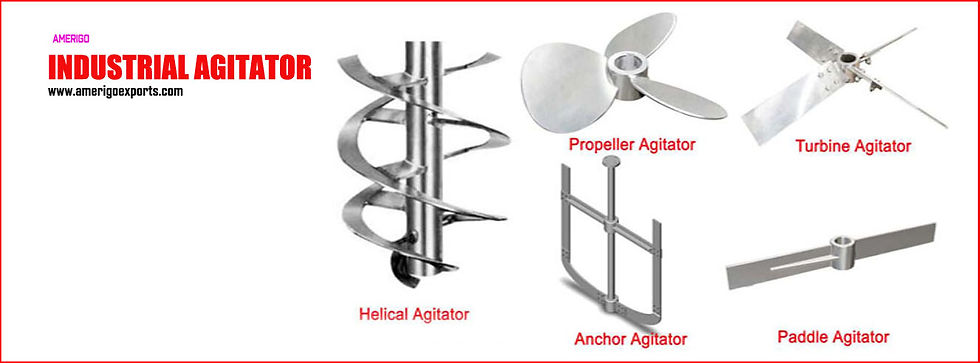Revolutionizing Centrifugal Pump Manufacturing: The Impact of Robotic Automation on Efficiency
- Amerigo Exports
- Jan 9
- 4 min read
Centrifugal Pump manufacturers in INDIA. In the ever-evolving landscape of manufacturing, companies are constantly searching for ways to improve efficiency and cut costs. One ground breaking technology that has been changing the game is robotic automation. In pump manufacturing, integrating robots has led to faster production times, improved quality control, and enhanced overall efficiency. This post takes a closer look at how robotic automation is reshaping the pump manufacturing industry, outlining its benefits and challenges.

Understanding Robotic Automation
Robotic automation involves using programmable machines to fulfill tasks traditionally performed by human labor. These robots can handle everything from simple repetitive activities to intricate processes requiring precision. In pump manufacturing, robotic automation includes tasks like assembly, welding, painting, and quality testing.
The push for automation typically arises from the need for higher efficiency, particularly in demanding sectors like pump manufacturing. According to recent data, adopting robotic automation can increase production efficiency by up to 30%.
Benefits of Robotic Automation in Pump Manufacturing
Increased Production Speeds
One standout advantage of robotic automation is its capability to significantly enhance production speeds. Robots can operate non-stop, eliminating the breaks, fatigue, and distractions that affect human workers. This results in higher output and allows manufacturers to fulfill tight deadlines more effectively.
For instance, a pump manufacturer that transitioned to a robotic assembly line reported a 40% increase in production capacity. This shift not only streamlined operations but also reduced lead times on orders from an average of three weeks to just one week.
Improved Precision and Quality Control
Precision is crucial in pump manufacturing. Robots excel at maintaining consistent quality by executing tasks with high accuracy. They can perform complex procedures—such as precise alignment—with minimal margin for error.
With the help of advanced sensors and machine learning algorithms, these robots continuously adapt and learn over time. A company that implemented robotic testing reported a 50% drop in defect rates, translating to higher customer satisfaction and lower costs associated with rework.
Enhanced Worker Safety
While concerns about job loss often accompany the rise of robotics, these systems can create safer workplaces. By handling dangerous or monotonous tasks, robots allow human employees to concentrate on more strategic roles that demand creativity and critical thinking.
For example, robots are now used to monitor and handle hazardous materials. Workers in facilities that adopted robotic safety protocols have reported a 20% reduction in workplace accidents.
Cost Reduction
Although the initial investment in robotic technology may seem daunting, the long-term savings can be substantial. Increased production speeds and fewer errors lead to significant cost savings.
A study found that manufacturers implementing automation can reduce operating costs by as much as 25%, thanks to lower labor expenses and minimized waste. Additionally, robots have lower maintenance needs than human workers and can operate in conditions that otherwise require expensive safety measures.
Flexibility and Scalability
Modern robotic systems are incredibly versatile, enabling manufacturers to adjust their production lines quickly to accommodate different pump models. They can be easily reprogrammed or reconfigured for various tasks, making them invaluable assets in manufacturing.
For instance, a firm that experienced fluctuating demand was able to cut down its production changeover time from several hours to just 30 minutes with robotic systems in place. This flexibility allows manufacturers to react promptly to market changes without sacrificing efficiency.
Challenges in Implementing Robotic Automation
High Initial Investment
One of the main hurdles in adopting robotic automation is the upfront financial investment needed for equipment and training. Smaller manufacturers may struggle to secure the necessary capital to upgrade to advanced robotic systems.
However, many companies recognize this investment as a long-term strategy. With efficiency gains often surpassing initial costs, the transition can be mutually beneficial.
Skilled Workforce Requirement
Despite robots taking over many tasks, a skilled workforce is essential for overseeing automated operations. Employees need training not only to manage these technologies but also to maintain and troubleshoot them.
Manufacturers that prioritize workforce development are better positioned to successfully integrate robotic systems and ensure long-term functionality.
Maintenance and Upkeep
Robotic systems require ongoing maintenance to function at their best. Manufacturers must allocate budget and resources for regular servicing and upgrades to keep operations smooth.
Establishing a preventive maintenance schedule can help avert unexpected breakdowns. This proactive approach reduces costly downtime and extends the lifespan of robotic equipment.
The Future of Robotic Automation in Pump Manufacturing
The future of robotic automation in pump manufacturing is bright as technology continues to advance. Innovations such as artificial intelligence, machine learning, and the Internet of Things (IoT) are poised to enhance robotic capabilities further.
By utilizing these technologies, manufacturers can improve not only efficiency but also gain valuable insights from production data. This leads to continuous improvement and better decision-making.
In summary, adopting robotic automation in pump manufacturing offers a range of benefits, including enhanced efficiency, quality, and safety. While there are challenges to overcome, the long-term advantages of this technology can significantly outweigh initial hurdles. As more manufacturers embrace robotic solutions, the industry will continue to evolve, paving the way for a more efficient and innovative future.

The role of robotic automation in pump manufacturing is transformative. By focusing on efficiency through automation, manufacturers can stay competitive in a complex market. This drive toward innovation will shape a future where efficiency and quality are integrated seamlessly into every manufacturing process.




Comments